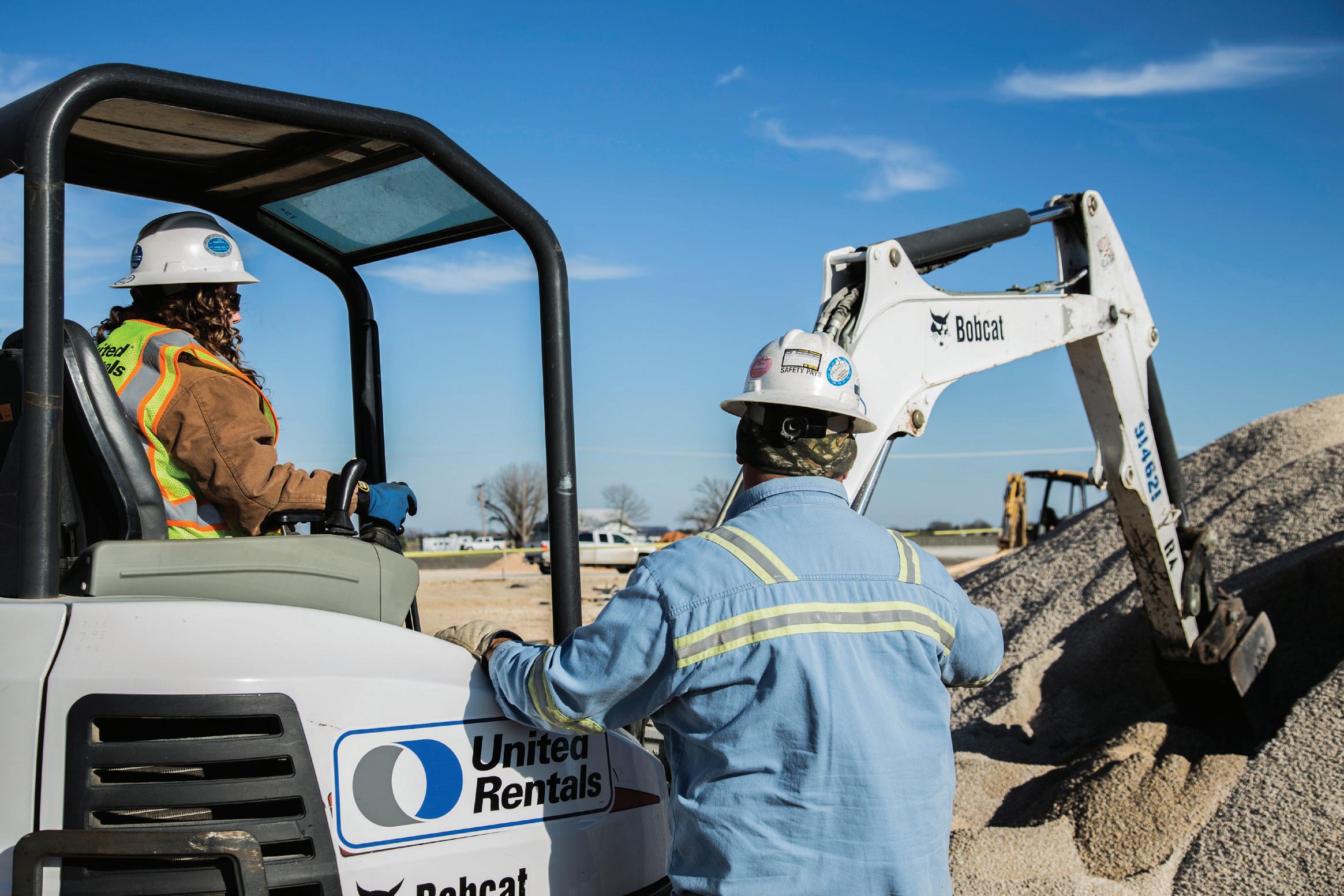
19 minute read
COMPACT EXCAVATOR ACQUISITION IS NO SMALL CHOICE
When it comes to compact excavators, the decision to buy, rent or lease calls for more than comparing costs.
Renting a compact excavator provides flexibility in terms of how long you hold onto the equipment, plus lets you select the machine size and configuration best suited for the application.
The uneven recovery in construction activity coupled with uncertainty about equipment availability and prospects for future work make for tough choices when it comes to acquiring equipment. The investment in even a smaller machine such as a compact excavator becomes a major decision.
The question becomes whether it’s more practical to buy the unit and have it on hand when and where it’s needed, or if it’s better to rent until you know you have both the project backlog and mix to justify the purchase. Leasing throws yet another potential acquisition option into the equation.
There can be benefits to each, but they depend largely on the situation and equipment utilization.
RENTAL’S REWARDS
rental item. A number of factors have driven this trend.
˜ Availability of capital:
Renting can help to maintain financial fluidity during times of uncertainty such as we saw throughout much of 2020 and into 2021. As a generalization, a longer-term rental over multiple months will typically run 4% to 5% of the cost to purchase, plus you avoid the sales tax required with outright acquisition.
˜ No long-term commitment:
Rental gives you the ability to use a specific machine to complete a job without making a long-term commitment to a specific size class. You can determine and acquire the best machine for each job — whether it’s a 1.5-ton unit on one project or a 4-ton machine on the next.
˜ Rental limits maintenance
exposure: If the rental equipment breaks down or fails to work properly, the cost of maintenance, repairs and equipment downtime fall to the rental company. You can simply return it and obtain a comparable replacement. ˜ Tax benefits: With rental, you pay the bill, charge it to the job and you can later deduct it as a cost of doing business. You don’t have to worry about depreciation, interest allocation or insurance.
“Another benefit of infusing rental equipment into a fleet strategy is the access to newer and more advanced fleets. Rental companies upgrade their fleets on a regular basis, giving contractors access to the most advanced gear and latest in control and operational technologies,” says Craig Schmidt, vice president, United Rentals.
A MATTER OF UTILIZATION
Of course, rental is not a onesize-fits-all solution. You need to look at all of the factors that can influence the most cost-effective way to obtain a compact excavator. They can include: ˜ the number of hours put on the machine annually; ˜ how long you intend to keep the equipment; ˜ maintenance costs required for the equipment each year; ˜ financing programs available when purchasing the machine; ˜ and the type of cash flow you are looking to obtain.
Of these, expected utilization typically tops the list. “The ‘buy’ conclusion has to be based on future utilization,” says Garry Bartecki, managing member of GB Financial Services LLP, and a consultant to the Independent Equipment Dealers Association. “Because you are committing to at least a 60- to 72-month financing payment cycle, you
had better be sure you have the work over this time period to cover cash flow requirements.”
Bartecki recommends purchasing the machine if you expect an annual time utilization of 60% or more based on 22 days of use per month. “From 40% to 60%, you are in middle ground, but you had better be sure you are going to hit the higher end of the spectrum. If you are not really, really sure about time utilization, then rent until you have a clearer picture,” he advises. “Lower than 40% is a rent situation.
“And let’s not forget transportation costs. If you own the trucks and trailers to move the equipment, you have another costly investment with zero time utilization when the construction equipment is in the field,” he points out.
The length of time you plan to hold onto the equipment is another consideration. The longer the time frame, the closer the stream of rental payments become to the purchase cost. So, if you have multiple projects that would get you to the point of 50% to 70% of the purchase price in rentals, it likely makes more sense to purchase the machine.
Even lower hour usage machines kept for longer terms may be more cost effective to purchase. However, make sure you understand your tax situation and current tax laws in effect for purchasing equipment to achieve the best benefit.
A LESSON IN LEASING
Lease agreements offer another means to acquire equipment without making a substantial upfront capital investment. They provide a fixed budget amount for an extended term, typically 12 to 36 months.
This can be a good option for those who don’t want to tie up working capital. It also allows you to rotate equipment on planned replacement cycles, which can potentially reduce maintenance and downtime costs. Plus, it may reduce the amount of tax paid to acquire the equipment.
Again, utilization typically determines if a lease is the most cost-effective solution. For example, if you are consistently renting the same size machine for four to five months a year, it may be worthwhile to consider a rent-to-own or lease agreement with purchase option at the end of the lease term.
The potential downsides vs. rental include maintenance costs; the potential that you may not need the equipment as long as expected; or requiring different equipment for different jobs.
With a lease, you are also locked into a long-term, fixed financial commitment. If a job gets cancelled, you’re on the hook for the payments for the duration of the lease, whether you have the work to cover the cost or not.
COST COMPARISONS
Comparing costs between a rental, purchase or lease can be a challenge. Rental rates can vary widely by market, so an accurate comparison is difficult.
Consider the following scenario: Say you rent a 3.5-ton excavator at a rate of $250 a day or $2,250 per month. (Rates shown are for example purposes only.) Now compare this to the payment rates for a loan or a lease based on a sales price of $42,000 at 0% for 36 months. The payment would be $1,166.67 per month. For a lease, the payment would be approximately $779 per month.
However, with a purchased or leased piece of equipment, you have an annual cost tied to it. For example, your annual payments on the loan would be roughly $14,000 or $9,348 with the lease, whether you use the machine or not. With a rental, you can return it at any time.
Owning and operating costs must be factored into your calculations, as well. Unfortunately, not everyone understands the true cost of owning equipment.
“Ownership cost is the realistic depreciation of the unit over the time you plan to keep it,” says Bartecki. “The residual should be based on the expected wholesale value at the end of the period taking into account the number of hours you expect to put on the machine.”
For easy figuring, let’s use a $100,000 piece of equipment as an example. “A $100,000 machine used for 2,000 hours a year for five years, with a 25% residual (of cost), generates $75,000 of depreciation or $7.50 per hour; interest comes out to approximately $3.70,” Bartecki notes. “So, if you use the unit for 2,000 hours annually, it is costing you $11.20 an hour. Use it less than the 2,000 hours and the hourly rate increases.
“At 1,000 hours, the $100,000 unit will cost about the same as a rental,” he continues. “And if that’s the case, I would rather rent because it provides a lot more flexibility.”
Next, calculate the cost to operate the machine. “These costs include normal wear and tear, inspections, preventive maintenance. Obviously, the older the unit gets, the higher the costs become. It would not be unusual for the operating costs to double the hourly ownership cost over the five-year period,” says Bartecki.
Continuing with the example, this would equate to an operating cost of $22 an hour, with a combined owning and operating cost of $33.20 per hour. Add in a couple of dollars for administrative costs and the overall cost comes to $35.20 per hour.
Now let’s look at how this compares to renting the $100,000 machine. Bartecki estimates rental companies in today’s market are basing monthly rental rates on about 3.5% to 4.0% of acquisition cost, or $3,500 to $4,000 per month. The weekly rate is based on roughly a third of the monthly rate and the daily rate on a third of the weekly rate — or $4,000 monthly, $1,350 weekly and $475 daily in this scenario.
“To compare, if you rent a unit for the full year, it will cost you $52,000 (or a negotiated rate for a full-year rental) compared to 2,000 hours times $35.20 per hour — or $70,400 — to own and operate,” Bartecki indicates. “Obviously, a new unit will experience lower operating costs that reduce the annual cost to somewhere close to the rental number. Lower time utilization also lowers your total cost to own and operate. Cost to own remains the same, but the hourly operating costs are lower only if you hit that 60% to 80% time utilization.” At 75% time utilization, the total cost should be similar to rental.
“Even if the cost to rent is similar to the cost to own and operate, you have to consider the other costs of ownership,” Bartecki advises, “namely the balance sheet effect and the flexibility rental provides to expand your business or go into new lines of work. Rental also frees up your borrowing and bonding capability.”
Ongoing financial conditions also favor rental. “With the post-pandemic situation, I would prefer to rent rather than buy until the financial markets settle down,” Bartecki comments. “The corporate, personal
and government debt could cause a lot of problems regarding debt loads and related cash flow requirements.”
As such, Bartecki’s advice is to “rent what you can and buy only what you must.”
“In many cases, rental is the way to go for contractors to protect their cash flow and capital base,” he states, “but dealers have to be prepared to support their customer base whether they need to own or rent equipment.” ET If the utilization for the compact excavator is expected to be over 60%, or you need to have the machine on site for extended periods of time, a purchase may prove to be the most costeffective option.
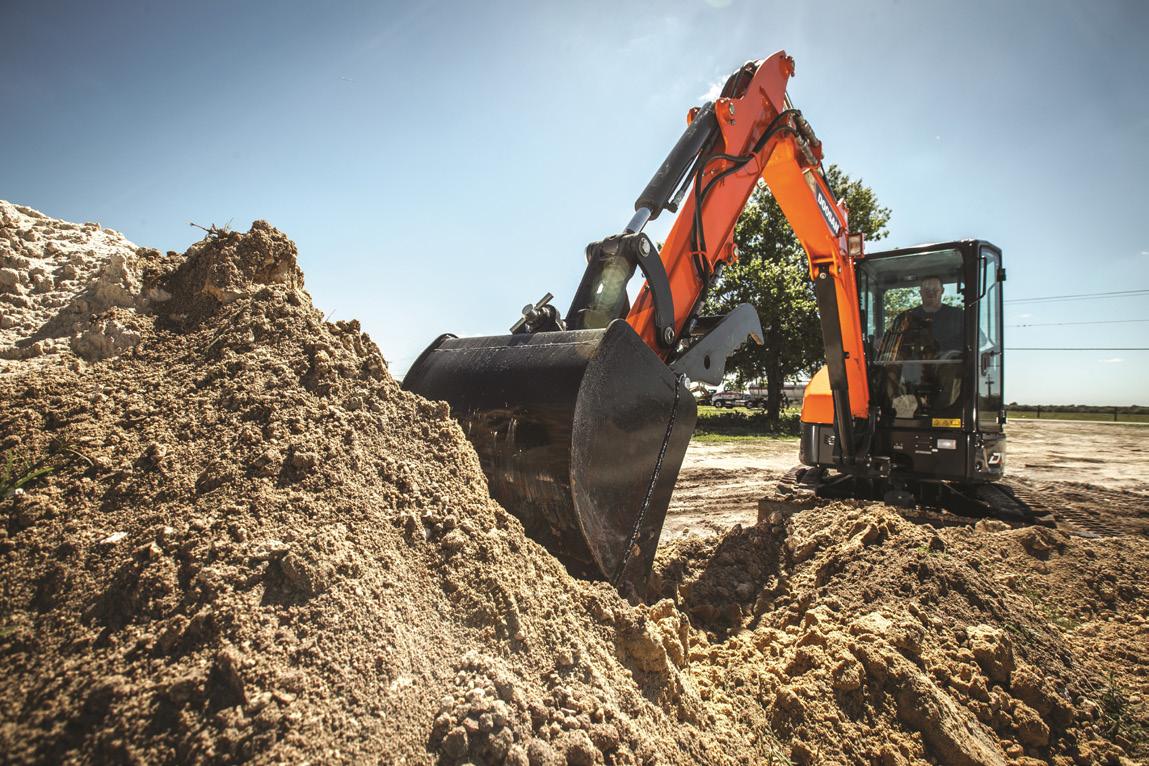
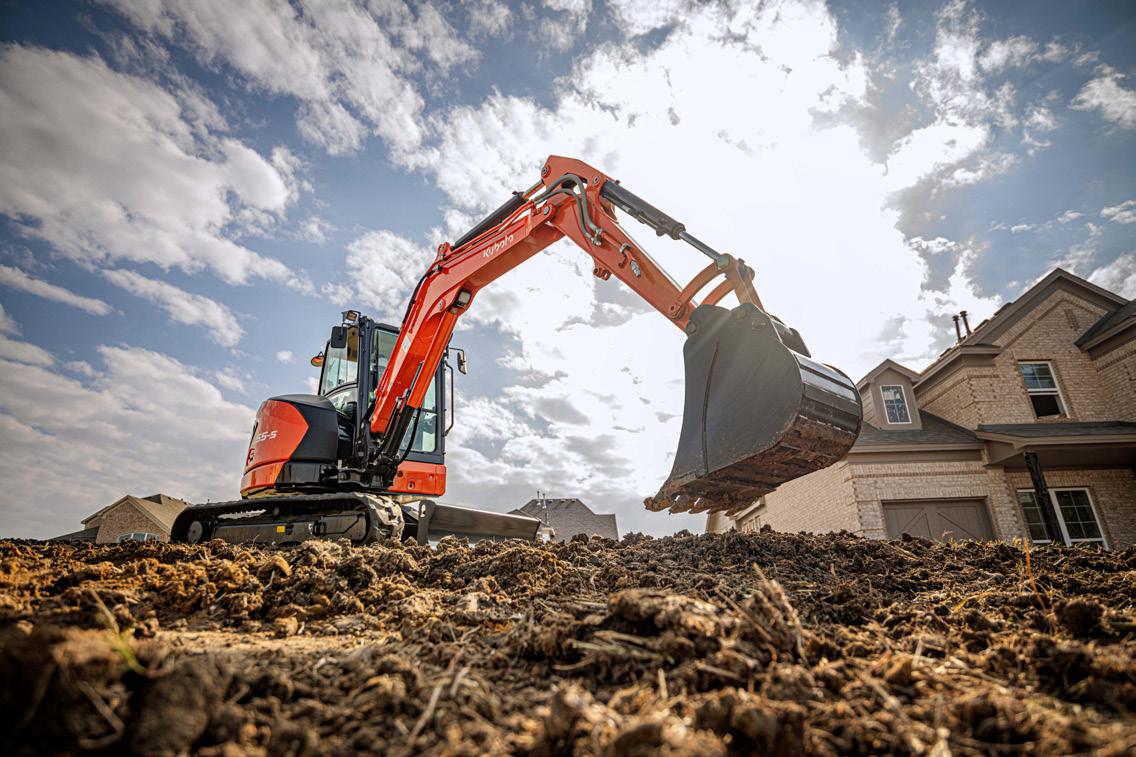
Additional information for this article provided by United Rentals and Doosan Infracore Construction Equipment.
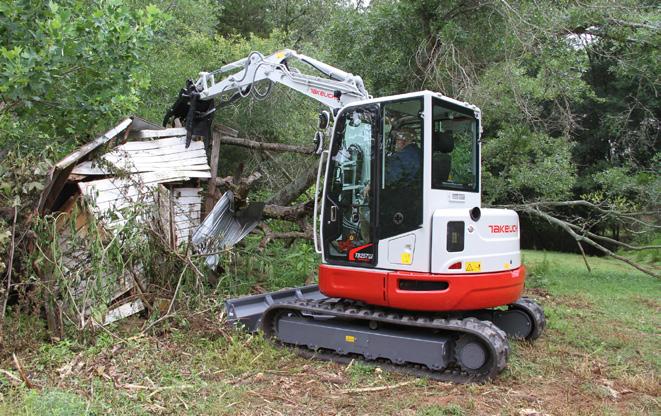
Takeuchi TB257FR Compact Hydraulic Excavator
The 12,765-lb. TB257FR has a tight tailswing and features a side-to-side offset boom that enables it to dig offset to the right or left side without needing to reposition the machine.
•Provides a 12-ft. 9.3-in. dig depth, 20-ft. 4.7-in. maximum reach and bucket breakout force of 10,431 lbs. •52.3-hp Kubota V2403-CR-TE5B turbocharged diesel engine with 141.5 ft.-lbs. of torque and equipped with a DOC and DPF exhaust aftertreatment system •Available cab provides air conditioning, heat, defrost, windshield wiper and washer, skylight with sunshade, AM/FM/ MP3 Bluetooth radio and a high-back suspension seat with head rest www.forconstructionpros.com/21195140
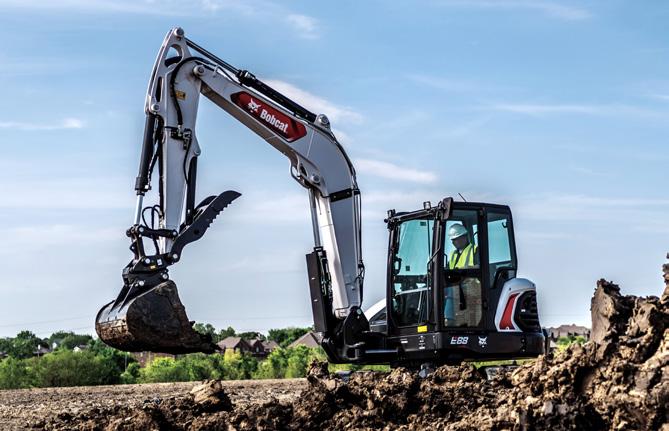
Bobcat R2-Series E88 Compact Excavator
The 19,600-lb. E88 features a 65.4-grosshp Bobcat Tier 4 turbocharged diesel engine and has up to a 14% increase in over-the-side lift capacity.
•182-in. dig depth and 282.5-in. reach •Comes with dual-flange track rollers, integrated counterweight, extra machine weight and added track on ground •Standard auto-idle, auto-shift, two-speed travel and 25.1-gpm auxiliary hydraulics •Spacious interior with control pattern selector under the seat, 5-in. display, password-protected keyless start and fingertip boom swing control •Optional 7-in. touchscreen, clamp diverter valve, add-on counterweight, rear view camera, angle blade and more www.forconstructionpros.com/21549918
John Deere 30G Compact Excavator
The 7,220-lb. 30G with reduced tailswing design is powered by a 23-hp Yanmar threecylinder Tier 4 engine and delivers a 9-ft. 2-in. dig depth.
•Auxiliary hydraulics plumbed to end of boom •Mechanical control pattern selector valve located beneath the seat •Includes a spacious operator station with large entryways and unrestricted sightlines •Third service door improves access to the cooling core and other daily checkpoints •Manual wedge-style quick coupler www.forconstructionpros.com/12313318
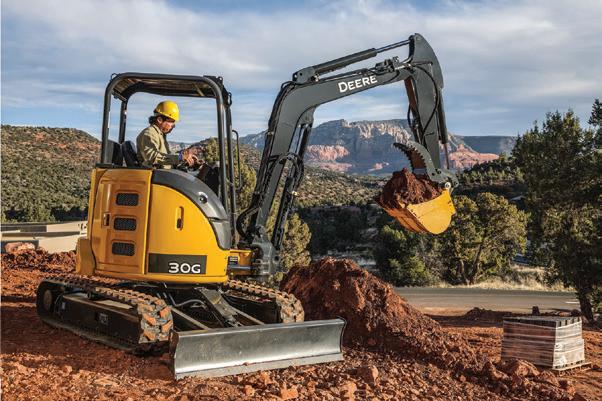
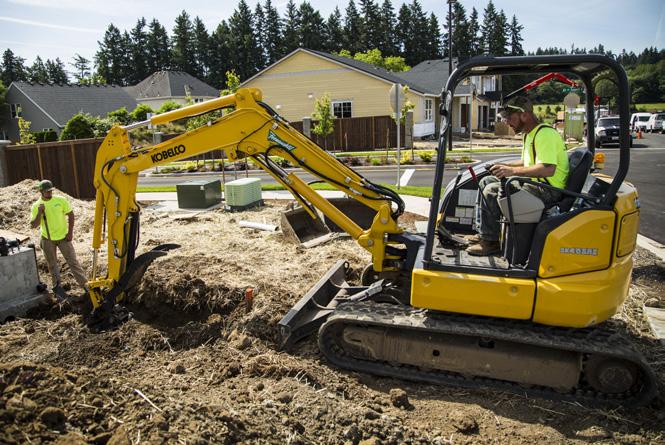
Kobelco Mini-excavator Lineup
Six mini-excavator models come in operating weights from 3,671 to 11,860 lbs. and minimal rear swing radius and zero tail overhang.
•14.5- to 37.4-hp diesel engines •Feature maximum digging depths from 7 ft. 3 in. to 12 ft. 10 in., maximum reach from 12 ft. 2 in. to 20 ft. 6 in. and breakout force from 3,395 to 11,128 lbs. •Standard bucket capacities from .06 to .20 cu. yds. •Feature wide swing angles and provide optimal side-ditch digging performance •Standard blade www.forconstructionpros.com/21121728

Case CX30C Zero Tailswing Compact Excavator
The CX30C has an operating weight of 6,020 lbs., a 24.8-hp Tier 4 Final engine and a bucket digging force of 4,520 lbs.
•Adjustable boom offset •Auto-shift travel system for operator convenience in varying terrain •Includes auxiliary hydraulic system with standard proportional controls, shut-off valve and easy to select joystick control patterns •Spacious, comfortable operator environment with optimal visibility, ergonomic controls, adjustable seating and line-of-sight digital displays www.forconstructionpros.com/20991942

Kubota U48-5 Tight Tailswing Compact Excavator
The U48-5 has an 11,057-lb. operating weight, 40.4 gross hp and a maximum digging depth of 10 ft. 8 in.
•Bucket breakout force of 9,304 lbs. •Offers a full-digital, full-color, 7-in. LCD screen with intuitive jog dial for single glance access to various functions •Optional keyless start •Comes in a canopy or cab model •Larger, redesigned cab with improved visibility and reduced noise www.forconstructionpros.com/21427885
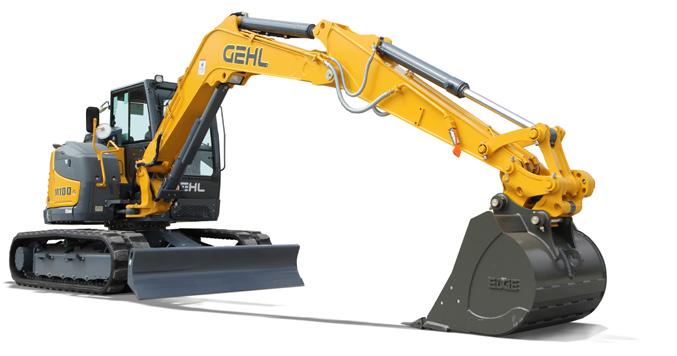
Gehl M100 Excavator
The 21,550-lb. M100 minimal tail excavator is the largest model in the company’s lineup, with a dig depth of 14 ft. 10 in. and a bucket breakout force of 12,216 lbf.
•Robust mono boom design will go 60° in either direction for consistent digging without the need to reposition the machine •72-hp (gross) 4TNV98CT-VBV diesel engine •16-ft. 10-in. dump height and ground level reach of 24 ft. 3 in. •Tailswing radius of 4 ft. 4 in. •“Power-A-Tach” quick-attach system www.forconstructionpros.com/20862583
Kato 50V5 Compact Excavator
The 50V5 has a 12-ft. 7-in. dig depth, 9,100 lbs. of breakout force at the bucket and weighs in at an easily towable 10,830 lbs.
•Kubota V2403-CR-E5B diesel engine rated at 43.5 hp at 2,400 rpm •43-gpm total hydraulic system flow and 16-gpm maximum auxiliary hydraulic flow •Features an offset boom, stable track frame and 6-ft. 6-in. dozer blade •Operating environment comes in open canopy or cab configurations with highly responsive pilot controls and easy to read instrument panels •Wide-opening access panels and large compartments ensure ease of service www.forconstructionpros.com/21366114
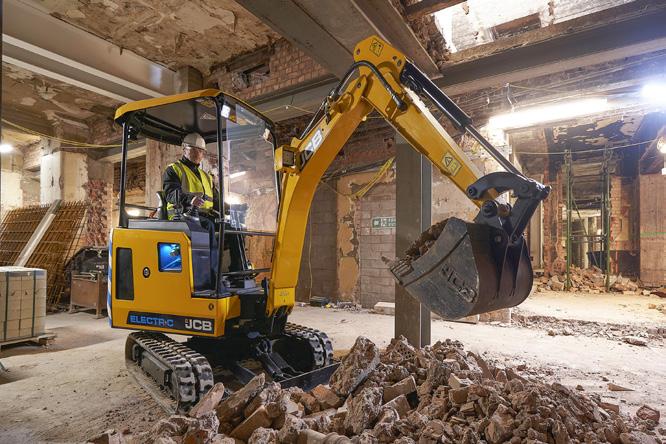
JCB 19C-1E Electric Mini-excavator
The 2-ton 19C-1E is powered by three lithium ion batteries creating 15 kWh of capacity to enable the unit to complete a typical day’s work on a single charge.
•Optional four-battery pack increases capacity to 20 kWh and delivers an additional two hours of continuous use •48-volt electric driveline generates peak power up to 27 hp •Bosch Rexroth load-sensing hydraulic system enables digging performance to a maximum depth of 9 ft. 3 in. •Features an onboard charger with standard domestic 110V input for 12-hour recharging, available 230V charging option for 8-hour recharge or fast charge option for 2-hour recharge www.forconstructionpros.com/21087944
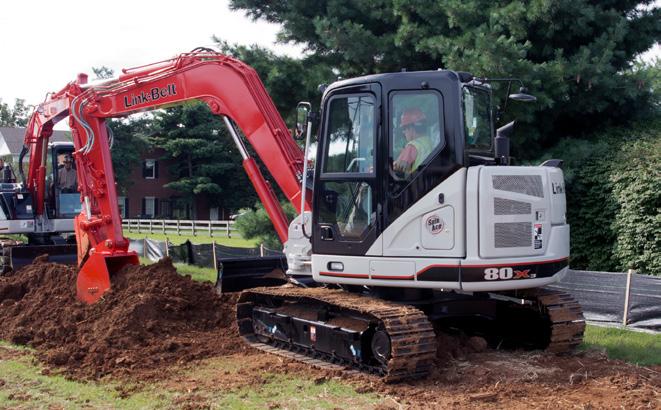
LBX Link-Belt 80 X3 Spin Ace Excavator
The 18,900-lb. Link-Belt 80 X3 Spin Ace has a 54-net-hp Isuzu Tier 4 Final turbocharged, no-DPF diesel engine that features one-touch idle and auto idle functions and auto engine warm-up.
•Speed Priority, Heavy and Applied Power engine work modes •Open-center hydraulics system with two Kawasaki variable-displacement axialpiston pumps and a Kawasaki gear pump •Delivers a 13-ft. 9-in. maximum dig depth, 22-ft. 9-in. reach at ground level and 12,800 lbf. of bucket digging force •Roomy ROPS/FOPS Level 1-certified pressurized cab with fully adjustable seat; ergonomic, low-effort joysticks; high-definition 7-in. LCD monitor and standard rear view camera www.forconstructionpros.com/21116235
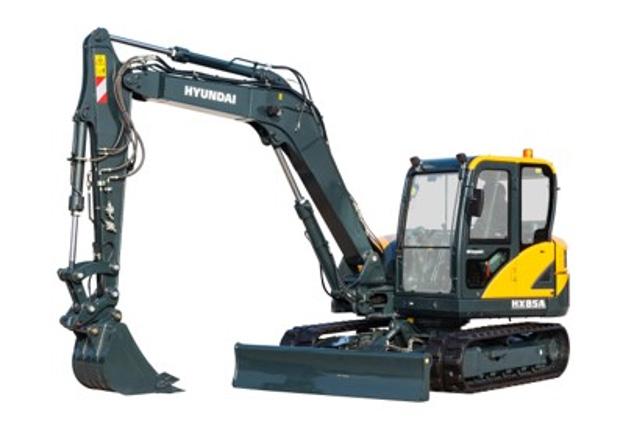

Hyundai HX85A Compact Excavator
The HX85A has an operating weight of 20,390 lbs. with a 12-ft. 10-in. twopiece boom and comes with a .33-cu.-yd. standard bucket capacity (SAE heaped).
•Quiet, eco-friendly Yanmar 4TNV98C four-cylinder engine delivers 65 net hp at 2,400 rpm. •Maximum digging depth of 14 ft. 2 in. •Load-sensing hydraulics •Comfortable, spacious cabin with 7-in. touchscreen monitor, adjustable auxiliary hydraulic circuits, proportional joystick controls and soft-grip dozer blade lever •Optional four-way dozer blade, rear view camera and travel alarm www.forconstructionpros.com/21121693
Mecalac Updated MCR Series
The updated 6MCR, 8MCR and 10MCR crawler skid excavators provide the swiftness of a skid steer with the rotation of an excavator for versatility and enhanced travel speeds.
•Combine a three-part arm and rotating ability to deliver 360° capability •Arm can be tucked in even with a full bucket for a true zero turn radius •Feature a hydrostatic transmission and drive motors with a dedicated pump to drive the motor •Capable of travel speeds up to 6.2 mph •CONNECT quick-coupler system allows operators to quickly transition between attachments without leaving the cab www.forconstructionpros.com/21136452
Volvo ECR50 and ECR58 Compact Excavators
The 5-ton ECR50 zero tailswing and updated 6-ton ECR58 short swing models have an in-track boom swing that ensures the swing post and cylinder remain within the track width when digging alongside obstacles.
•41.8- and 48-hp Volvo engines •8,134 and 9,422 lbs. of breakout force •Standard ECO mode, engine auto-idle and autoengine shutdown features •Spacious cabs include intuitive controls with an automotive-style menu wheel and 5-in. color display •ECR50 includes reinforced digging equipment, undercarriage and hoods, plus a 50-hour greasing interval and easy access service points www.forconstructionpros.com/21319144
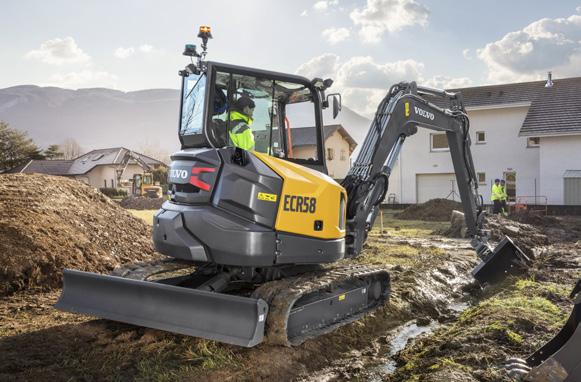
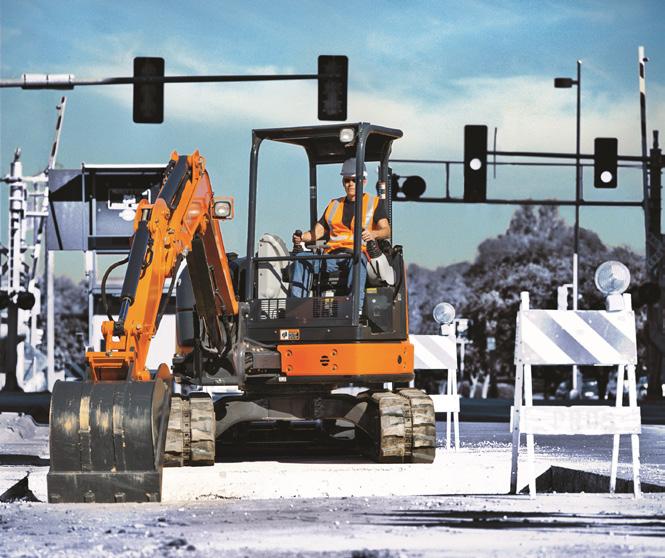
Hitachi ZX60USB-5 Compact Excavator
The 13,547-lb. ZX60USB-5 features a 12-ft. 4-in. maximum dig depth and 20-ft. 5-in. maximum dig reach.
•Fuel-efficient 53-hp (net) Yanmar Tier 4 Final diesel engine •Power/economy work modes match engine speed to the job •Ergonomic short-throw pilot control levers provide smooth, predictable loweffort fingertip operation •Heavy-duty X-frame undercarriage provides a solid, stable platform •Standard backfill blade or optional allhydraulic blade angles 25° left or right www.forconstructionpros.com/12311298
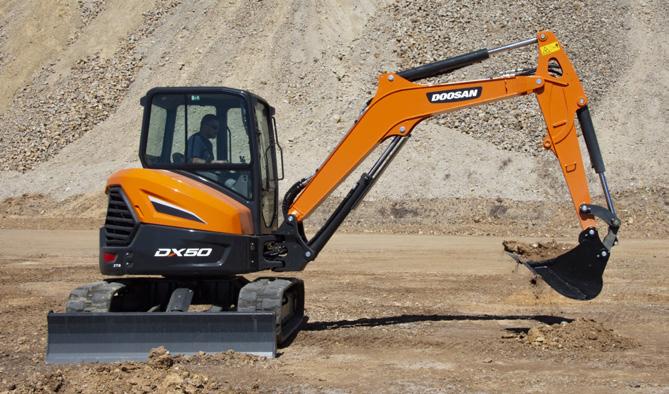
Doosan DX42-5K and DX50-5K Compact Excavators
The 10,114-lb. DX42-5K and 11,486lb. DX50-5K offer maximum dig depths of 10 ft. 5 in. and 11 ft. 5 in. and are powered by fuel-efficient 42.6- and 49.7-hp Doosan three-cylinder diesel engines.
•Dual-flange track roller system and enhanced counterweight for better over the side digging and lifting capabilities •Integrated lift eye •Dozer blade top edge has a more durable design and a blade and frame designed with angled top and rounded edges •Easy to reach auxiliary hydraulic couplers •Standard enclosed, air conditioned cab with wider seats, responsive joystick controls and joystick buttons and 5-in. display panel www.forconstructionpros.com/21159585

Komatsu PC88MR-11 Excavator
The 67.7-hp PC88MR-11 reduced tailswing excavator has an 18,739- to 19,224-lb. operating weight and bucket digging force (SAE) of 11,982 lbs., with a bucket capacity of .12 to .26 cu. yds.
•Standard high-flow auxiliary hydraulics with proportional joysticks for precise attachment control •Six working modes for tailoring to task •High-efficiency Tier 4 Final engine and viscous fan clutch work together to lower overall fuel consumption by up to 13% •Standard 7-ft. 7-in. grading blade •Quiet, climate-controlled cab with air suspension seat, Bluetooth radio and highresolution monitor with rear view camera www.forconstructionpros.com/21366856
Yanmar SV40 Compact Excavator
The 9,206-lb. SV40 ultra-tight tailswing excavator is powered by a 39-hp Yanmar electronically controlled, Tier 4 Final diesel engine.
•11-ft. 3-in. digging depth •Ultra-tight turning and boom swing enable work in confined spaces •VIO progressive three-pump hydraulic system (VIPPS) •Cab comes standard with ECO Mode, Auto-Decel Mode and backfill blade lever-controlled with float position, twospeed operation and an LCD monitor •SMARTASSIST remote communication system •Standard hydraulic quick coupler www.forconstructionpros.com/21131888
Caterpillar Next Generation Mini-excavators
The 302.7 CR, 303 CR and 303.5 CR with compact swing radius weigh from 7,133 to 9,239 lbs. and feature 23.6-net-hp C1.1 turbocharged, Tier 4 Final diesel engines with standard auto idle and auto engine shutdown.
•96.5-, 104.3- and 110.6-in. dig depths •Feature stick steer, cruise control, operator adjustable settings and tilt-up canopy or cab •Two travel ranges up to 2.8 mph •Fixed undercarriage widths of 59.1, 61.0 and 70.1 in. with an expandable undercarriage option on the 302.7 CR •Standard dozer blade and float function •Load-sensing hydraulics provide up to 26-gpm flow www.forconstructionpros.com/21551347
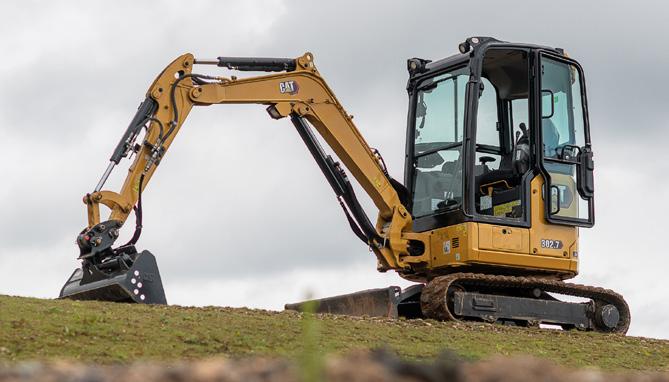
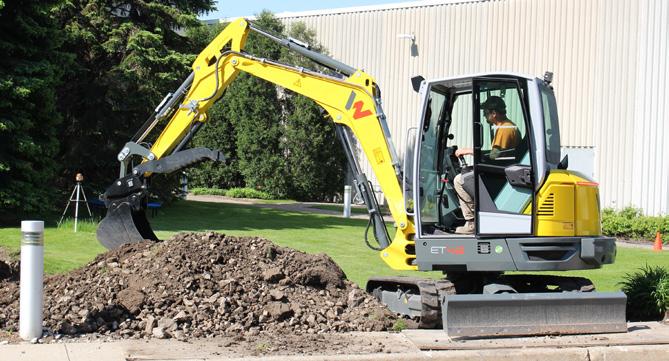
Wacker Neuson ET42 Excavator
The 4.2-ton ET42 features a low-profile hood design, expanded side window glass, large windows and offset boom that provide a complete view of the boom, attachment and working area.
•Three-point bucket linkage system offers a 200° angle of rotation and greater vertical digging depth •Dual flange rollers in undercarriage improve stability and provide a smoother ride with less vibration •Comes in cab or canopy with LED working lights and optional angle blade or redesigned Vertical Digging System •Cab models have air conditioning, a fourposition windshield design, 3.5-in. color display, cell phone charger and holder, air cushioned seat and adjustable arm rest www.forconstructionpros.com/21123349
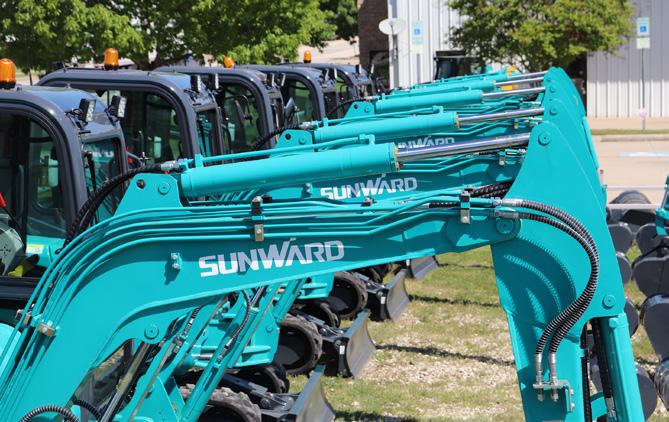
Sunward Excavator Line
Sunward offers mini- to full-size excavators to the North American market.
•Models range from the 4,145-lb., 18-hp SWE-18UF to the 78,400-lb., 338-hp SWE-365F •Maximum digging depths from 7 ft. 3 in. to 24 ft. 6 in. •Maximum reach at ground level ranges from 12 ft. 11 in. to 37 ft. 2 in. •Standard bucket capacities from .0515 to 1.9606 cu. yds. •Large models include a heavy hydraulic system, strong swing and rotation system, power traveling system and a stable and reliable chassis www.forconstructionpros.com/21135902



